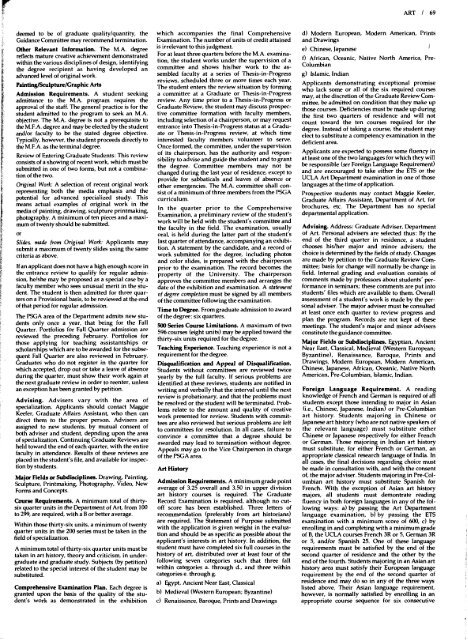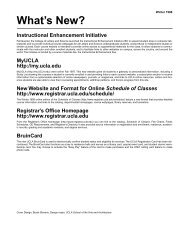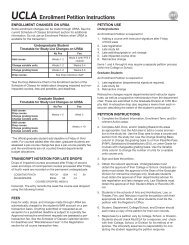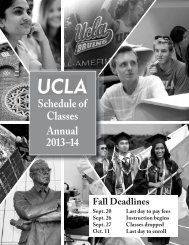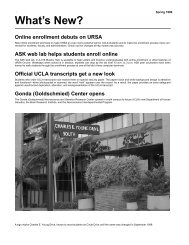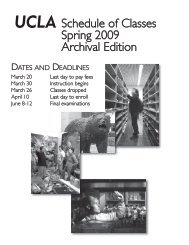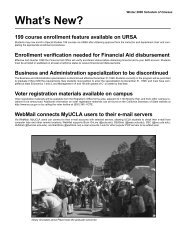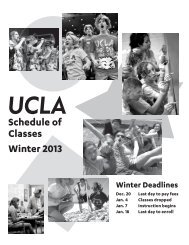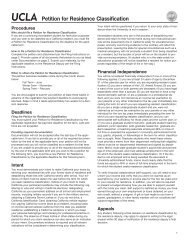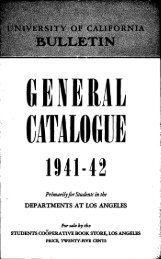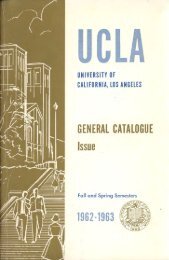UCLA Graduate Catalog 1980-81 - Registrar - UCLA
UCLA Graduate Catalog 1980-81 - Registrar - UCLA
UCLA Graduate Catalog 1980-81 - Registrar - UCLA
Create successful ePaper yourself
Turn your PDF publications into a flip-book with our unique Google optimized e-Paper software.
ART / 69<br />
deemed to be of graduate quality/quantity, the which accompanies the final Comprehensive d) Modern European, Modern American, Prints<br />
Guidance Committee may recommend termination. Examination. The number of units of credit attained and Drawings<br />
is irrelevant to this judgment.<br />
Other Relevant Information . The M.A. degree<br />
reflects mature creative achievement demonstrated<br />
For at least three quarters before the M.A. examina-<br />
within the various disciplines of design, identifying tion, the student works under the supervision of a<br />
the degree recipient as having developed an<br />
committee and shows his/her work to the as-<br />
advanced level of original work.<br />
sembled faculty at a series of Thesis-in-Progress<br />
reviews, scheduled three or more times each year.<br />
Painting /Sculpture /Graphic Arts<br />
The student enters the review situation by forming<br />
Admission Requirements . A student seeking a committee at a <strong>Graduate</strong> or Thesis-in-Progress<br />
admittance to the M.A. program requires the review. Any time prior to a Thesis-in-Progress or<br />
approval of the staff. The general practice is for the <strong>Graduate</strong> Review, the student may discuss prospec-<br />
student admitted to the program to seek an M.A. tive committee formation with faculty members,<br />
objective. The M.A. degree is not a prerequisite to including selection of a chairperson, or may request<br />
the M.F.A. degree and may be elected by the student entrance into Thesis-in-Progress status at a Gradu-<br />
and/or faculty to be the stated degree objective. ate or Thesis-in-Progress review, at which time<br />
Typically, however, the student proceeds directly to interested faculty members volunteer to serve.<br />
the M.F.A. as the terminal degree.<br />
Once formed, the committee, under the supervision<br />
Review of Entering <strong>Graduate</strong> Students: This review<br />
of its chairperson, has the authority and responsibility<br />
to advise and guide the student and to grant<br />
consists of a showing of recent work, which must be<br />
submitted in one of two forms, but not a combina-<br />
the degree. Committee members may not be<br />
changed during the last year of residence, except to<br />
tion of the two.<br />
provide for sabbaticals and leaves of absence or<br />
Original Work: A selection of recent original work other emergencies. The M.A. committee shall con-<br />
representing both the media emphasis and the sist of a minimum of three members from the PSGA<br />
potential for advanced specialized study. This curriculum.<br />
means actual examples of original work in the<br />
In the quarter prior to the Comprehensive<br />
media of painting, drawing, sculpture printmaking,<br />
Examination, a preliminary review of the student's<br />
photography. A minimum of ten pieces and a maxi-<br />
work will be held with the student's committee and<br />
mum of twenty should be submitted.<br />
the faculty in the field. The examination, usually<br />
or<br />
oral, is held during the latter part of the student's<br />
Slides, made from Original Work: Applicants may last quarter of attendance, accompanying an exhibi-<br />
submit a maximum of twenty slides using the same tion. A statement by the candidate, and a record of<br />
criteria as above.<br />
work submitted for the degree, including photos<br />
and color slides, is prepared with the chairperson<br />
If an applicant does not have a high enough score in prior to the examination. The record becomes the<br />
the entrance review to qualify for regular admis- property of the University. The chairperson<br />
sion, he/she may be proposed as a special case by a approves the committee members and arranges the<br />
faculty member who sees unusual merit in the stu- date of the exhibition and examination. A statement<br />
dent. The student is then admitted for three quar- of degree completion must be signed by all members<br />
ters on a Provisional basis, to be reviewed at the end of the committee following the examination.<br />
of that period for regular admission.<br />
Time to Degree . From graduate admission to award<br />
The PSGA area of the Department admits new stu- of the degree: six quarters.<br />
dents only once a year, that being for the Fall 500 Series Course Limitations . A maximum of two<br />
Quarter. Portfolios for Fall Quarter admission are 596 courses (eight units) may be applied toward the<br />
reviewed the preceding February. Portfolios for<br />
thirty-six units required for the degree.<br />
those applying for teaching assistantships or<br />
scholarships which are to be awarded for the subse- Teaching Experience . Teaching experience is not a<br />
quent Fall Quarter are also reviewed in February. requirement for the degree.<br />
<strong>Graduate</strong>s who do not register in the quarter for Disqualification and Appeal of Disqualification.<br />
which accepted, drop out or take a leave of absence Students without committees are reviewed twice<br />
during the quarter, must show their work again at yearly by the full faculty. If serious problems are<br />
e) Chinese, Japanese<br />
f) African, Oceanic, Native North America, Pre-<br />
Columbian<br />
g) Islamic, Indian<br />
Applicants demonstrating exceptional promise<br />
who lack some or all of the six required courses<br />
may, at the discretion of the <strong>Graduate</strong> Review Committee,<br />
be admitted on condition that they make up<br />
those courses. Deficiencies must be made up during<br />
the first two quarters of residence and will not<br />
count toward the ten courses required for the<br />
degree. Instead of taking a course, the student may<br />
elect to substitute a competency examination in the<br />
deficient area.<br />
Applicants are expected to possess some fluency in<br />
at least one of the two languages for which they will<br />
be responsible (see Foreign Language Requirement)<br />
and are encouraged to take either the ETS or the<br />
<strong>UCLA</strong> Art Department examination in one of those<br />
languages at the time of application.<br />
Prospective students may contact Maggie Keefer,<br />
<strong>Graduate</strong> Affairs Assistant, Department of Art, for<br />
brochures, etc. The Department has no special<br />
departmental application.<br />
Advising . Address: <strong>Graduate</strong> Adviser, Department<br />
of Art. Personal advisers are selected thus: By the<br />
end of the third quarter in residence, a student<br />
chooses his/her major and minor advisers; the<br />
choice is determined by the fields of study. Changes<br />
are made by petition to the <strong>Graduate</strong> Review Committee;<br />
basis for change will normally be change in<br />
field. Internal grading and evaluation consists of<br />
comments made by professors about students' performance<br />
in seminars ; these comments are put into<br />
students' files which are available to them. Overall<br />
assessment of a student 's work is made by the personal<br />
adviser. The major adviser must be consulted<br />
at least once each quarter to review progress and<br />
plan the program. Records are not kept of these<br />
meetings. The student' s major and minor advisers<br />
constitute the guidance committee.<br />
Major Fields or Subdisciplines . Egyptian, Ancient<br />
Near East, Classical, Medieval (Western European;<br />
Byzantine), Renaissance, Baroque, Prints and<br />
Drawings, Modern European, Modern American,<br />
Chinese, Japanese, African, Oceanic, Native North<br />
American, Pre-Columbian, Islamic, Indian.<br />
the next graduate review in order to reenter, unless<br />
an exception has been granted by petition.<br />
Advising . Advisers vary with the area of<br />
specialization. Applicants should contact Maggie<br />
Keefer, <strong>Graduate</strong> Affairs Assistant, who then can<br />
direct them to the proper person. Advisers are<br />
assigned to new students, by mutual consent of<br />
both adviser and student, depnding upon the area<br />
of specialization. Continuing <strong>Graduate</strong> Reviews are<br />
held toward the end of each quarter, with the entire<br />
faculty in attendance. Results of these reviews are<br />
placed in the student's file, and available for inspection<br />
by students.<br />
identified at these reviews, students are notified in<br />
writing and verbally that the interval until the next<br />
review is probationary, and that the problems must<br />
be resolved or the student will be terminated. Problems<br />
relate to the amount and quality of creative<br />
work presented for review. Students with committees<br />
are also reviewed but serious problems are left<br />
to committees for resolution. In all cases, failure to<br />
convince a committee that a degree should be<br />
awarded may lead to termination without degree.<br />
Appeals may go to the Vice Chairperson in charge<br />
of the PSGA area.<br />
Art History<br />
Foreign Language Requirement . A reading<br />
knowledge of French and German is required of all<br />
students except those intending to major in Asian<br />
(i.e., Chinese, Japanese, Indian) or Pre-Columbian<br />
art history. Students majoring in Chinese or<br />
Japanese art history (who are not native speakers of<br />
the relevant language) must substitute either<br />
Chinese or Japanese respectively for either French<br />
or German. Those majoring in Indian art history<br />
must substitute, for either French or German, an<br />
appropriate classical research language of India. In<br />
all cases, the final decisions regarding choice must<br />
be made in consultation with, and with the consent<br />
Major Fields or Subdisciplines . Drawing, Painting,<br />
Sculpture, Printmaking, Photography, Video, New<br />
Forms and Concepts.<br />
Admission Requirements . A minimum grade point<br />
average of 3.25 overall and 3.50 in upper division<br />
art history courses is required. The <strong>Graduate</strong><br />
of, the major adviser. Students majoring in Pre-Columbian<br />
art history must substitute Spanish for<br />
French. With the exception of Asian art history<br />
majors , all students must demontrate reading<br />
Course Requirements . A minimum total of thirty- Record Examination is required, although no cut- fluency in both foreign languages in any of the folsix<br />
quarter units in the Department of Art, from 100 off score has been established. Three letters of lowing ways: a) by passing the Art Department<br />
to 299, are required, with a B or better average. recommendation (preferably from art historians) language examination, b) by passing the ETS<br />
Within those thirty-six units, a minimum of twenty<br />
quarter units in the 200 series must be taken in the<br />
field of specialization.<br />
are required. The Statement of Purpose submitted<br />
with the application is given weight in the evaluation<br />
and should be as specific as possible about the<br />
applicant's interests in art history. In addition, the<br />
examination with a minimum score of 600, c) by<br />
enrolling in and completing with a minimum grade<br />
of B, the <strong>UCLA</strong> courses French 3R or 5, German 3R<br />
or 5, and/or Spanish 25. One of these language<br />
A minimum total of thirty-six quarter units must be student must have completed six full courses in the requirements must be satisfied by the end of the<br />
taken in art history, theory and criticism, in undergraduate<br />
and graduate study. Subjects (by petition)<br />
related to the special interest of the student may be<br />
substituted.<br />
history of art, distributed over at least four of the<br />
following seven categories such that three fall<br />
within categories a. through d., and three within<br />
categories e. through g.<br />
second quarter of residence and the other by the<br />
end of the fourth. Students majoring in an Asian art<br />
history area must satisfy their European language<br />
requirement by the end of the second quarter of<br />
Comprehensive Examination Plan . Each degree is<br />
granted upon the basis of the quality of the stu-<br />
a) Egypt, Ancient Near East, Classical<br />
b) Medieval (Western European; Byzantine)<br />
residence and may do so in any of the three ways<br />
listed above. Their Asian language requirement,<br />
however, is normally satisfied by enrolling in an<br />
dent's work as demonstrated in the exhibition c) Renaissance, Baroque, Prints and Drawings appropriate course sequence for six consecutive


